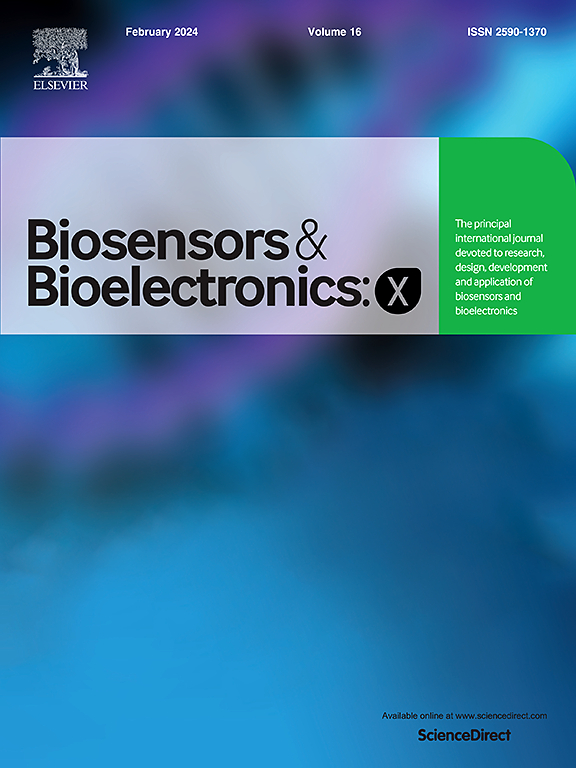乳酸检测的分子印迹和纳米材料协同作用
IF 10.61
Q3 Biochemistry, Genetics and Molecular Biology
引用次数: 0
摘要
基于分子印迹聚合物(MIP)的电化学传感器已经成为有前途的非酶平台,用于选择性和稳定地检测临床和环境相关的生物标志物。这篇综述对基于mip的乳酸传感技术的最新进展进行了批判性的全面分析,特别强调了将导电纳米材料(包括金纳米颗粒和银纳米颗粒)、激光诱导石墨烯和还原氧化石墨烯集成在一起的混合系统。这些协同组合利用增强的表面积、电导率和分子识别来提高传感器的灵敏度、选择性和长期运行稳定性。关键的制造策略,如电聚合,绿色纳米材料合成和表面印迹,严格审查其在优化印迹灵敏度和电子转移效率方面的作用。应用领域涵盖可穿戴健康设备的实时乳酸监测到复杂矩阵的环境监测。尽管取得了重大进展,但与可重复性、模板去除效率、抗结垢性和可扩展制造相关的挑战仍然存在。该综述最后概述了未来的发展方向,包括集成到灵活的纸质平台,以及开发智能的可植入系统。随着不断创新,基于mip的乳酸传感器将成为下一代即时诊断和环境监测技术的重要组成部分。本文章由计算机程序翻译,如有差异,请以英文原文为准。
Molecular imprinting and nanomaterial synergy for lactate detection
Molecularly imprinted polymer (MIP)-based electrochemical sensors have emerged as promising non-enzymatic platforms for the selective and stable detection of clinically and environmentally relevant biomarkers. This review provides a critical, comprehensive analysis of recent advances in MIP-based lactate sensing, with particular emphasis on hybrid systems that integrate conductive nanomaterials including gold and silver nanoparticles, laser-induced graphene, and reduced graphene oxide. These synergistic combinations leverage enhanced surface area, electrical conductivity, and molecular recognition to improve sensor sensitivity, selectivity, and long-term operational stability. Key fabrication strategies, such as electropolymerization, green nanomaterial synthesis, and surface imprinting, are critically examined for their roles in optimizing imprinting sensitivity and electron transfer efficiency. Application areas span real-time lactate monitoring in wearable health devices to environmental surveillance in complex matrices. Despite significant progress, challenges related to reproducibility, template removal efficiency, fouling resistance, and scalable manufacturing persist. The review concludes by outlining future directions, including integration into flexible and paper-based platforms, and the development of smart, implantable systems. With continued innovation, MIP-based lactate sensors are poised to become essential components in next-generation point-of-care diagnostics and environmental monitoring technologies.
求助全文
通过发布文献求助,成功后即可免费获取论文全文。
去求助
来源期刊

Biosensors and Bioelectronics: X
Biochemistry, Genetics and Molecular Biology-Biophysics
CiteScore
4.60
自引率
0.00%
发文量
166
审稿时长
54 days
期刊介绍:
Biosensors and Bioelectronics: X, an open-access companion journal of Biosensors and Bioelectronics, boasts a 2020 Impact Factor of 10.61 (Journal Citation Reports, Clarivate Analytics 2021). Offering authors the opportunity to share their innovative work freely and globally, Biosensors and Bioelectronics: X aims to be a timely and permanent source of information. The journal publishes original research papers, review articles, communications, editorial highlights, perspectives, opinions, and commentaries at the intersection of technological advancements and high-impact applications. Manuscripts submitted to Biosensors and Bioelectronics: X are assessed based on originality and innovation in technology development or applications, aligning with the journal's goal to cater to a broad audience interested in this dynamic field.
 求助内容:
求助内容: 应助结果提醒方式:
应助结果提醒方式:


